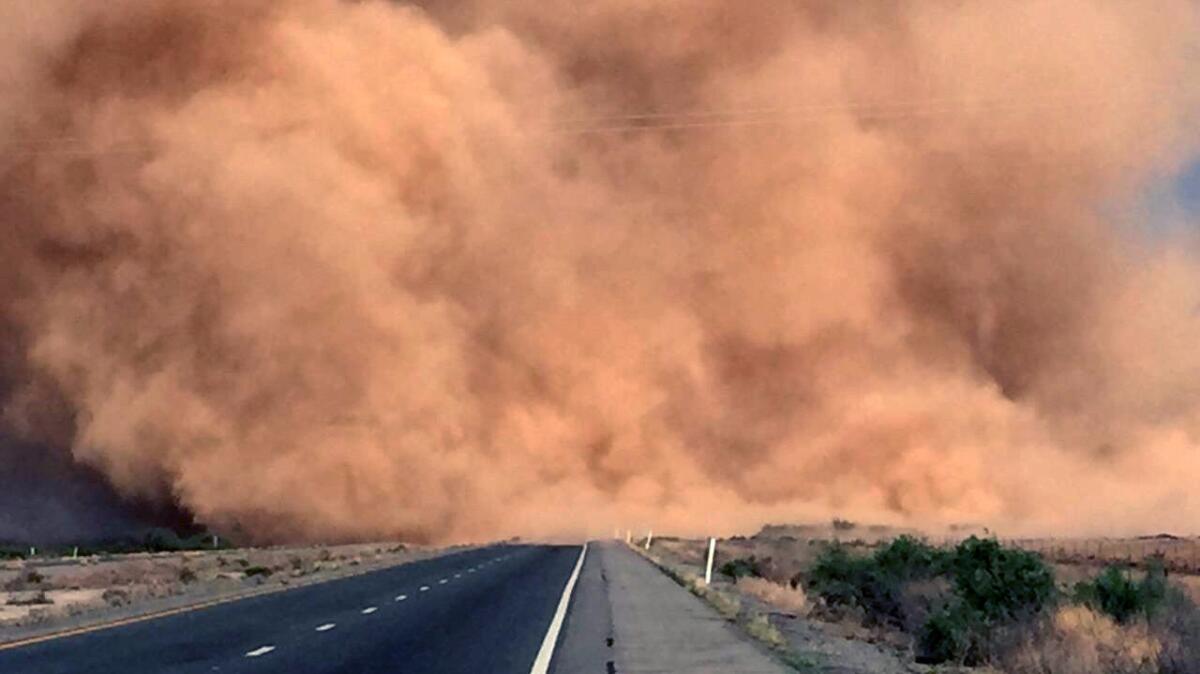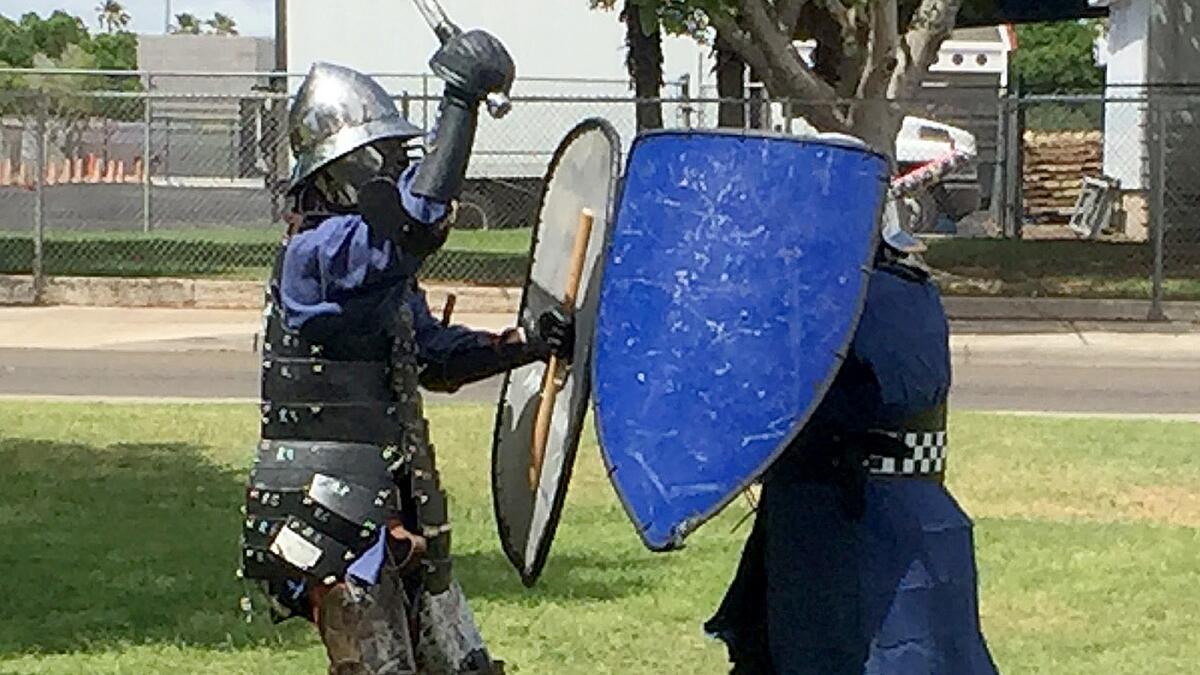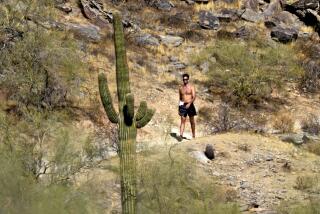It’s summer in Arizona. Time to come inside

Reporting from Yuma, Ariz. — In northern climes, dead leaves, gardeners bringing their plants inside and children praying for school closures all signal one thing: Winter is blowing in hard and mean.
Here in Arizona, they mark something else. It’s not winter. It’s summer. The leaves are curling up and dying of heat. Gardeners bring in their plants, fearing not frost but the first truly hot day. And when children supplicate a higher power for bad weather, they’re praying for school-shuttering monsoons.
It gets unpleasant quickly.
— Matthew Chew
Summer in southern Arizona isn’t the stuff of warm, sepia-tinted afternoons spent cannonballing into the lake. Here, summer means the death of citrus, tree branches once bowed by immense bushels of fruit now hovering limp and bare, providing little shade over blinding white noontime sidewalks.
“It gets unpleasant quickly,” said Matthew Chew of Arizona State University’s Center for Biology and Society in Tempe as he shelled palo verde beans in his kitchen. He, too, sees the signs of summer’s approach: The late-spring migrating birds in his backyard are almost all gone, along with his students and every snowbird senior citizen that can afford to pack up and roll to cooler summer RV pads.
Yuma is the driest, sunniest and hottest major city in a hot state. Average daily high temperatures hit 100 degrees here in June and don’t look back for the better part of four months.
See more of our top stories on Facebook >>
That means anything outdoors that doesn’t include a pool or a lake is pretty much out of the question. Goodbye bike rides, adios trail running, and so long … sword fights?

Yes, even for a dozen men and women clad head-to-toe in padding, helmets and shields in a Yuma park one Saturday afternoon, the climbing temperatures were as telltale a sign of the coming dead season as falling leaves and the first dusting of snow in cold winters.
“This right here is the flashy part,” said Mark Syck, pointing to a man who swung a rubber-capped steel rod down on his opponent’s head. Both were sweating heavily in their helmets and heavily padded shirts.
Syck was supervising mostly clumsy novices in the Society for Creative Anachronism, which counts 30,000 members across the world who reenact a sanitized version of medieval Europe. They dress in the costumes of the period and give themselves nicknames and back stories.
Their devotion to historical accuracy is serious, but the SAC members understand that what they do is not really fighting. It’s not that serious. It’s playing.
And in Arizona, it’s almost time to come inside.
In the low deserts of southern Arizona, all movement halts. The sidewalks are empty. People hide in air-conditioned structures and draw the shades. They start their cars before breakfast, not to warm up as is the custom in Minnesota or Maine, but to cool down with the air conditioning on full blast.
“You don’t have to shovel sunshine,” goes a popular plug for Arizona’s weather. That’s true, but it would be nice to move the heat along after the sun sets. Instead it lays thick in the valleys where modern Arizonans chose to site some of their largest cities.
Where winter elsewhere forces residents to bundle themselves in layers, summer here can also mean more clothing – wide-brimmed hats, long sleeves and keffiyeh. The preferred gloves are oven mitts – to handle the searing-hot steering wheel.
In Northern winters, when the weather turns, life enters a state of hibernation. The same can be said for summers here, where even the plants slow down. Desert shrubs have adapted to limit their activity during the day, and stop expending energy when the weather is hottest.
“Some parts of photosynthesis stop until it’s dark out,” Chew said. “They’re holding their breath all day.”
Other plants, like ocotillo, shed their deciduous leaves when they can no longer sustain the water to keep the leaves fed. Only a row of barren stems remain.
“They all have some kind of adaptation to cope with the problem of limited water,” Chew said. “Live fast, die young. That’s the winning evolutionary strategy.”
Humans’ adaptations have been much more uneven. While the armored medieval reenactors have learned to scurry indoors when summer approaches, previous Southwest residents sometimes decided to simply call it quits with the weather.
As a previous drought cycle here turned to its driest, the Hohokam and Anasazi tribes are thought to have abandoned massive settlements sometime before the 14th century.
Now, Arizona is once again in the grip of a cyclical drought, Chew said, as well as the potential effects of climate change, including massive dust storms called haboobs.
“The last few years, we’ve seen some changes,” Chew said. “Haboobs were really not a feature of this place 10 years ago. Five or six years ago they became the regular thing.”
“We used to have dust storms, but nothing like these massive, news-making 5,000-foot walls of dirt.”
There is little question that humans have mastered the climate inside their homes. Air conditioning and automobiles helped spur massive growth in the former agricultural outposts of Yuma and Phoenix.
Are we really so far away from defeating the climate outside our walls?
Chew assures that there is no stopping the wind shift that brings the sudden onset of summer to this region, no magical mechanical device that can reverse the flow to maintain Arizona’s mild, even temperatures the rest of the year.
“No, I don’t think anything like that would work,” Chew said. “They used to put airplane propellers between the tops of citrus trees to keep [cold] air moving, but even all the airplane engines you could find would not help. It is what it is.”
In these last days of late spring, southern Arizona waits, its breath held, for the wind to shift and summer to come bellowing in, unbidden and unwelcome, punishing this region for another season.
Relief won’t come until months later.
The birds will return to professor Matthew Chew’s backyard. The RVs will rumble back into their lots. Arizona State students will brag about wearing short sleeves to football games. The citrus trees will buckle with fruit and the dust storms will stop.
Winter is on its way.
ALSO
No free charging for Model 3? Tesla can explain
Here are 100 people in Hollywood who could help fix the academy’s diversity problem
Professor killed in UCLA murder-suicide was brilliant, kind and caring, colleagues say
More to Read
Sign up for Essential California
The most important California stories and recommendations in your inbox every morning.
You may occasionally receive promotional content from the Los Angeles Times.











